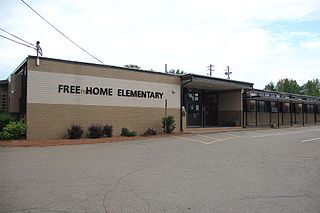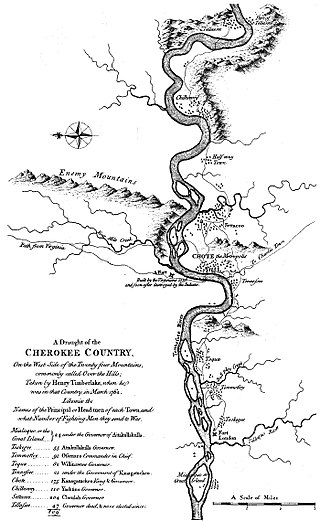
Cherokee County is located in the US state of Georgia. As of the 2020 Census, the population was 266,620. The county seat is Canton. The county Board of Commissioners is the governing body, with members elected to office. Cherokee County is included in the Atlanta Metropolitan Area.

Canton is a city in and the county seat of Cherokee County, Georgia, United States. As of the 2010 census, the city had a population of 22,958, up from 7,709 in 2000.

Gold Ridge is the historical name of an unincorporated community in Cherokee County, Georgia, United States.

Sixes, home to approximately 14,540, is an unincorporated community in western Cherokee County, Georgia, United States, located about three miles west of Holly Springs and near the eastern shore of current-day Lake Allatoona. The community is located in the Georgia Gold Belt, which runs southwest to northeast along the southern edge of the Blue Ridge mountains. The Sixes Gold Mine, a now-defunct gold mine dating back to the early 19th century, was located just to the northwest. In addition, the community is home to the Sixes Mill, which was originally built around 1820 by early gold prospectors and later rebuilt circa 1880. The mill has been well preserved and is still located off Sixes Road. There are two theories on how Sixes derived its name. The first theory attributes the name to Fort Hinar Sixes, a Cherokee Indian removal fort that was located in the area along the Trail of Tears. The second holds that the name is derived from an old Cherokee village that was located near the Etowah River named "Sutali" — the Cherokee word for the number six. Sixes also lent its name to Fort Sixes, an 1830s US Army fort that served as a removal collection point for Cherokee prior to the Trail of Tears. Sutallee, a community that sits on the opposite side of the Etowah River in western Cherokee County, also derives its name from this Native American village. Today, Sixes is a growing suburban community with many large, upscale residential neighborhoods, including BridgeMill. The area is served by two elementary schools ; one middle school (Freedom); and two high schools.

Sutallee is an unincorporated community in western Cherokee County, Georgia, United States. Located about two miles northwest of current-day Lake Allatoona, it is one of the county's earliest white settlements. It is believed that former Georgia Governor and U.S. Senator Joseph E. Brown maintained a farm in the area, on lowlands near the Etowah River, and was there harvesting wheat when told of the surprising news that he had been nominated for governor. Sutallee derives its unique name, which is often spelled "Sutalee" or "Suttallee", from an old Cherokee village that was located near the Etowah River named "Sutali" — the Cherokee word for the number six. Sixes, a community that sits on the eastern side of Lake Allatoona, also derives its name from this Native American village. Today, Sutallee is traversed by Georgia Highway 20 and remains mostly rural.

Keithsburg, population 205, is an unincorporated community in Cherokee County, Georgia, United States.

Free Home is an unincorporated community in the eastern part of Cherokee County, Georgia, United States. Centered at the intersection of state highways 20 and 372, the rural community has seen moderate suburbanization of the area since the late 1990s. It is home to Free Home Elementary School. The community is home to a Publix Supermarket center, which has a few stores/restaurants. There is also a Tractor Supply Company that was completed in September 2011.

Overhill Cherokee was the term for the Cherokee people located in their historic settlements in what is now the U.S. state of Tennessee in the Southeastern United States, on the western side of the Appalachian Mountains. This name was used by 18th-century European traders and explorers from British colonies along the Atlantic coast, as they had to cross the mountains to reach these settlements.

Orange is an unincorporated community located in eastern Cherokee County between the communities of Macedonia and Lathemtown in the U.S. state of Georgia. Orange was the second community in Cherokee County upon the county's inception in 1832. This community was at its height during the later portion of the 18th century due to its location on the main highway into Forsyth County. It had a post office, a general store, and Orange United Methodist, one of the first churches in Cherokee.

The Cohutta Mountains is a mountain range in Georgia, U.S.
Crane Eater is an unincorporated community in Gordon County, in the U.S. state of Georgia.
Hemp is an unincorporated community in Fannin County, in the U.S. state of Georgia.
Aska is an unincorporated community in Fannin County, in the U.S. state of Georgia.
Conasauga is an extinct town in Gilmer County, in the U.S. state of Georgia.
Dougherty is an unincorporated community in Dawson County, in the U.S. state of Georgia.
Mica is an unincorporated community in Cherokee County, in the U.S. state of Georgia.
Quill is an unincorporated community in Gilmer County, in the U.S. state of Georgia.
Vanna is an unincorporated community in Hart County, in the U.S. state of Georgia.

Victoria is an unincorporated community in Cherokee County, in the U.S. state of Georgia.
Bellview is an unincorporated community in Cherokee County, in the U.S. state of North Carolina. It is part of Notla Township, and is located immediately north of the Georgia border, about 10 miles south of Murphy, NC. Its average elevation is 1800 feet above sea level. U.S. Route 19 is the main highway through Bellview.












